Gallium compound GaQ(3) -induced Ca(2+) signalling triggers p53-dependent and -independent apoptosis in cancer cells
- PMID: 22074401
- PMCID: PMC3417493
- DOI: 10.1111/j.1476-5381.2011.01780.x
Gallium compound GaQ(3) -induced Ca(2+) signalling triggers p53-dependent and -independent apoptosis in cancer cells
Erratum in
- Br J Pharmacol. 2016 Feb;173(3):627
-
Erratum.Br J Pharmacol. 2016 Feb;173(3):627. doi: 10.1111/bph.13412. Epub 2016 Jan 27. Br J Pharmacol. 2016. PMID: 31265508 Free PMC article.
Abstract
BACKGROUND AND PURPOSE A novel anti-neoplastic gallium complex GaQ(3) (KP46), earlier developed by us, is currently in phase I clinical trial. GaQ(3) induced S-phase arrest and apoptosis via caspase/PARP cleavage in a variety of cancers. However, the underlying mechanism of apoptosis is unknown. Here, we have explored the mechanism(s) of GaQ(3) -induced apoptosis in cancer cells, focusing on p53 and intracellular Ca(2+) signalling. EXPERIMENTAL APPROACH GaQ(3) -induced cytotoxicity and apoptosis were determined in cancer cell lines, with different p53 status (p53(+/+) , p53(-/-) and p53 mutant). Time course analysis of intracellular Ca(2+) calcium release, p53 promoter activation, p53-nuclear/cytoplasmic movements and reactive oxygen species (ROS) were conducted. Ca(2+) -dependent formation of the p53-p300 transcriptional complex was analysed by co-immunoprecipitation and chromatin immunoprecipitation. Ca(2+) signalling, p53, p300 and ROS were serially knocked down to study Ca(2+) -p53-ROS ineractions in GaQ(3) -induced apoptosis. KEY RESULTS GaQ(3) triggered intracellular Ca(2+) release stabilizing p53-p300 complex and recruited p53 to p53 promoter, leading to p53 mRNA and protein synthesis. p53 induced higher intracellular Ca(2+) release and ROS followed by activation of p53 downstream genes including those for the micro RNA mir34a. In p53(-/-) and p53 mutant cells, GaQ(3) -induced Ca(2+) -signalling generated ROS. ROS further increased membrane translocation of FAS and FAS-mediated extrinsic apoptosis. CONCLUSIONS AND IMPLICATIONS This study disclosed a novel mechanism of Ca(2+) -signalling-mediated p53 activation and ROS up-regulation. Understanding the mechanism of GaQ(3) -induced apoptosis will help establish this gallium-based organic compound as a potent anti-cancer drug.
© 2011 The Authors. British Journal of Pharmacology © 2011 The British Pharmacological Society.
Figures
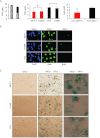
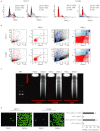
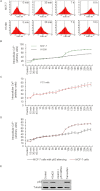
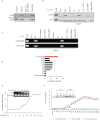
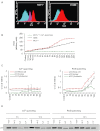
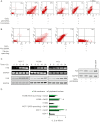
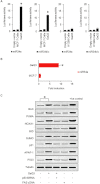
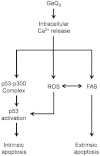
Similar articles
-
Novel p53-dependent anticancer strategy by targeting iron signaling and BNIP3L-induced mitophagy.Oncotarget. 2016 Jan 12;7(2):1242-61. doi: 10.18632/oncotarget.6233. Oncotarget. 2016. PMID: 26517689 Free PMC article.
-
p53 increases intra-cellular calcium release by transcriptional regulation of calcium channel TRPC6 in GaQ3-treated cancer cells.PLoS One. 2013 Aug 16;8(8):e71016. doi: 10.1371/journal.pone.0071016. eCollection 2013. PLoS One. 2013. PMID: 23976973 Free PMC article.
-
The gallium complex KP46 exerts strong activity against primary explanted melanoma cells and induces apoptosis in melanoma cell lines.Melanoma Res. 2009 Oct;19(5):283-93. doi: 10.1097/CMR.0b013e32832b272d. Melanoma Res. 2009. PMID: 19584767 Free PMC article.
-
ROS and p53: a versatile partnership.Free Radic Biol Med. 2008 Apr 15;44(8):1529-35. doi: 10.1016/j.freeradbiomed.2008.01.011. Epub 2008 Jan 26. Free Radic Biol Med. 2008. PMID: 18275858 Free PMC article. Review.
-
Ca2+ signalling checkpoints in cancer: remodelling Ca2+ for cancer cell proliferation and survival.Nat Rev Cancer. 2008 May;8(5):361-75. doi: 10.1038/nrc2374. Nat Rev Cancer. 2008. PMID: 18432251 Review.
Cited by
-
NCX2 Regulates Intracellular Calcium Homeostasis and Translocation of HIF-1α into the Nucleus to Inhibit Glioma Invasion.Biochem Genet. 2023 Jun;61(3):979-994. doi: 10.1007/s10528-022-10274-9. Epub 2022 Nov 5. Biochem Genet. 2023. PMID: 36334237 Free PMC article.
-
Aberrant calcium signalling downstream of mutations in TP53 and the PI3K/AKT pathway genes promotes disease progression and therapy resistance in triple negative breast cancer.Cancer Drug Resist. 2022 Jun 21;5(3):560-576. doi: 10.20517/cdr.2022.41. eCollection 2022. Cancer Drug Resist. 2022. PMID: 36176752 Free PMC article. Review.
-
p53's choice of myocardial death or survival: Oxygen protects infarct myocardium by recruiting p53 on NOS3 promoter through regulation of p53-Lys(118) acetylation.EMBO Mol Med. 2013 Nov;5(11):1662-83. doi: 10.1002/emmm.201202055. Epub 2013 Oct 1. EMBO Mol Med. 2013. PMID: 24096875 Free PMC article.
-
Novel p53-dependent anticancer strategy by targeting iron signaling and BNIP3L-induced mitophagy.Oncotarget. 2016 Jan 12;7(2):1242-61. doi: 10.18632/oncotarget.6233. Oncotarget. 2016. PMID: 26517689 Free PMC article.
-
8-Hydroxyquinoline-Amino Acid Hybrids and Their Half-Sandwich Rh and Ru Complexes: Synthesis, Anticancer Activities, Solution Chemistry and Interaction with Biomolecules.Int J Mol Sci. 2021 Oct 19;22(20):11281. doi: 10.3390/ijms222011281. Int J Mol Sci. 2021. PMID: 34681939 Free PMC article.
References
-
- Barton C, Davies D, Balkwill F, Burke F. Involvement of both intrinsic and extrinsic pathways in IFN-gamma-induced apoptosis that are enhanced with cisplatin. Eur J Cancer. 2005;41:1474–1486. - PubMed
-
- Bennett M, Macdonald K, Chan SW, Luzio JP, Simari R, Weissberg P. Cell surface trafficking of Fas: a rapid mechanism of p53-mediated apoptosis. Science. 1998;282:290–293. - PubMed
-
- Berridge MJ. Inositol trisphosphate and calcium signalling. Nature. 1993;361:315–325. - PubMed
-
- Camello-Almaraz C, Gomez-Pinilla PJ, Pozo MJ, Camello PJ. Mitochondrial reactive oxygen species and Ca2+ signaling. Am J Physiol Cell Physiol. 2006;291:C1082–C1088. - PubMed
-
- Campaner S, Spreafico F, Burgold T, Doni M, Rosato U, Amati B, et al. The Methyltransferase Set7/9 (Setd7) Is Dispensable for the p53-Mediated DNA Damage Response In Vivo. Mol Cell. 2011;43:681–688. - PubMed
Publication types
MeSH terms
Substances
LinkOut - more resources
Full Text Sources
Other Literature Sources
Research Materials
Miscellaneous

